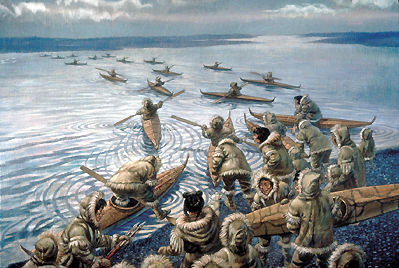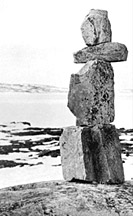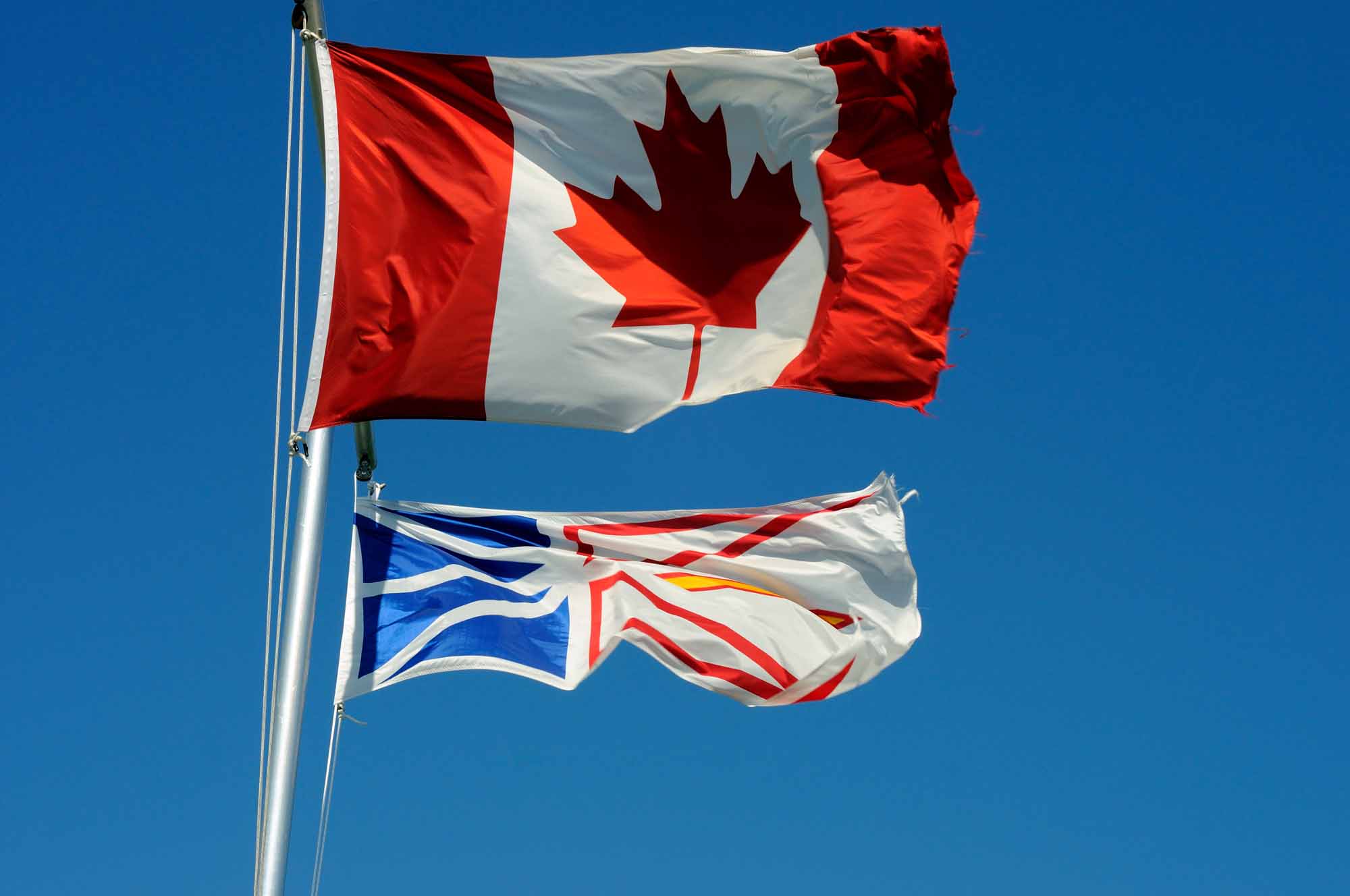Nunatsiavut (meaning “our beautiful land” in Inuktitut) is the homeland of the Labrador Inuit (Labradormiut). The territory covers 72,520km2 of land and 44,030km2 of sea in the northern part of the Labrador Peninsula. On 1 December 2005, the Labrador Inuit celebrated the creation of the Nunatsiavut Government, their own regional government within the province of Newfoundland and Labrador. The Labradormiut became the first Inuit in Canada to achieve self-government. Of the approximately 6,500 beneficiaries, about 2,500 live within the settlement area in five communities: Rigolet, Postville, Makkovik, Hopedale (the legislative capital) and Nain (the administrative capital).

Map of Nunatsiavut
(Courtesy of Judicieux, Wikimedia Commons)
History
Nunatsiavummiut (meaning “people of Nunatsiavut” in Inuktitut) are descendants of the ancient Early Inuit (Thule) hunters who were drawn to northern Labrador by its abundant wildlife. The Inuit lived a nomadic life until 1771, when Moravian missionaries established a permanent presence in Labrador. The missionaries brought Christianity and a new trade system, which dramatically changed Inuit culture and lifestyle. Unfortunately, they also brought diseases that almost wiped out whole communities (see Moravian Missions in Labrador).
After Newfoundland joined Confederation in 1949, services to the Inuit were taken over by the provincial government. Inuit children were subjected to the residential school system. In the 1950s, without prior consultation, the government decided to close several Inuit communities and relocate all Inuit farther south. Labrador Inuit survived many traumatic events, but their resilience led them to decide that the time had come to take their destiny into their own hands (See Indigenous Self-Government in Canada.)
Creation of Nunatsiavut
In 1973, the Labrador Inuit Association (LIA) was formed as a regional affiliate of Inuit Tapirisat of Canada (now known as Inuit Tapiriit Kanatami or ITK). The LIA was formed to promote Inuit culture, improve the health and well-being of Labrador Inuit, protect constitutional, democratic and human rights, and advance Labrador Inuit claims. The LIA was incorporated and officially recognized on 26 March 1975 (March 26 is now a statutory holiday in Nunatsiavut to mark the LIA’s importance in Nunatsiavut’s history). In 1977, the LIA filed a land claim with Newfoundland and Labrador and with Canada’s federal government. Negotiations began in 1988 and an agreement-in-principal was reached in June 2001. On 26 May 2004, the agreement was ratified by 76 per cent of eligible voters. On 6 December 2004, the provincial government gave effect to the Labrador Inuit Land Claims Agreement Act. Finally, on 23 June 2005 the agreement received Senate approval and royal assent from Canada’s governor general.
On 1 December 2005, Nunatsiavummiut became the first Inuit in Canada to achieve self-government when their constitution was formally adopted and the Nunatsiavut Government, their own regional government within Newfoundland and Labrador, was created. Members of the LIA board of directors formed the interim government.
The Nunatsiavut Government represents about 6,500 Labrador Inuit. In the 2016 Census, it was reported that 2,558 people live in the five communities located within Nunatsiavut: Nain (Nunatsiavut’s administrative capital, 1,125 people); Hopedale (Nunatsiavut’s legislative capital, 574 people); Makkovik (377 people); Rigolet (305 people, known as the world’s most southerly Inuit community); and Postville (177 people). An Inuit Community Government (ICG) has been established in each of these five places. Each ICG is headed by an AngajukKâk (“community leader”) who sits at the Nunatsiavut Assembly.
If an urban area of Canada outside Nunatsiavut is home to 10 per cent or more of all Labrador Inuit, the Nunatsiavut Government must put in place an Inuit Community Corporation (ICC). At present, there are two ICCs: NunaKatiget ICC and Sivunivut ICC, which represent beneficiaries living in Happy Valley-Goose Bay/Mud Lake and North West River/Sheshatshiu, respectively.

Flag of Nunatsiavut
(Courtesy of Jorge Candeias, Wikimedia Commons)
Nunatsiavut Parliament and Assembly
The founding and governing principles driving the Nunatsiavut government are found in the Labrador Inuit Constitution, approved by referendum in 2002. Inuttut (an Inuktitut dialect) and English are the official languages. The flag initially adopted in the early 1970s by the Labrador Inuit Association (LIA) was chosen as the flag of Nunatsiavut. It features a white, green and blue inuksuk reproducing the colours of Labrador's flag.
The first elected Nunatsiavut Assembly was sworn in on 17 October 2006. Since September 2012, the Assembly has sat at the new legislative building in Hopedale. This unique structure was conceived by local artist Sonny “Boy” Winters. He incorporated various elements of the Labrador Inuit culture in his design. For example, the entrance is shaped as an igloo and the floors are tiled with labradorite (a mineral found near Nain and named by Moravian missionaries). A legend states that labradorite reflects the colours of the northern lights once imprisoned in it. The Assembly members take seats at a table in the form of an ulu, and the roof is topped with a green inuksuk inside the steeple.
To make sure that the operational and political levels of government run independently from one another, the Nunatsiavut Parliament functions by consensus as opposed to the party system used by the Canadian federal and provincial jurisdictions. The Nunatsiavut Assembly is made up of:
- The President of Nunatsiavut;
- Ten Ordinary Members (two for Nain, one for Hopedale, one for Makkovik, one for Rigolet, one for Postville; two for Labrador Inuit living in Upper Lake Melville constituency (representing Happy Valley-Goose Bay, North West River and Mud Lake); and two for Labrador Inuit residing elsewhere in Canada);
- The AngajukKâk of each of the five communities in Nunatsiavut; and
- The chairperson of both Inuit Community Corporations (ICC)
Because Nunatsiavut is an ethnic model of governance, general election voters must be Labrador Inuit (Beneficiaries) aged 16 years or older and live in Canada. The presidency is the only position elected by all eligible voters in Nunatsiavut. Ordinary members and head (AngajukKâk) of each Inuit Community Government (ICG) are elected by residents of the communities.

Makkovik, 1985
(Courtesy of Gord McKenna, flickr)
Nunatsiavut Government Departments
Even though Nunatsiavut is still part of the province of Newfoundland and Labrador, the Nunatsiavut Government has authority over several areas. For instance, it can make and enforce laws. It can also define policies and turn them into programs and services for beneficiaries and residents.
The following seven departments have been established:
- Culture, Recreation and Tourism;
- Education and Economic Development;
- Finance, Human Resources and Information Technology;
- Health and Social Development;
- Land and Natural Resources;
- Nunatsiavut Affairs (overall management of the Nunatsiavut Government, Registrar of Beneficiaries; Legal Services; Community Relations; Housing; Community Justice; and Public Property);
- Nunatsiavut Secretariat (advice and administrative support to the Nunatsiavut Executive Council, strategic planning and management activities for the Nunatsiavut Government, intergovernmental relations and communications activities
Economy
Nunatsiavut Group of Companies (NGC) is the business arm of the Nunatsiavut Government. Its mission is to create wealth in trust for beneficiaries by owning profitable, sustainable enterprises.
Businesses fully owned by NGC include Nunatsiavut Construction (residential and commercial projects), Nunatsiavut Marine (passenger and freight service), and Nuluak (owner of shrimp, Greenland halibut or “turbot,” and Atlantic halibut quotas). NGC is also a partner in Air Borealis (passenger and cargo air transportation) and Universal Helicopters.
The main employers in Nunatsiavut are the Nunatsiavut Government; the Voisey’s Bay mine, a nickel deposit discovered near Nain in 1993 (about 50 per cent of the approximately 500 employees are Innu or Inuit and about 80 per cent of contracts are with Innu and Inuit businesses); the Torngat Fish Producers Co-operative and the schools in each community.
Geography
Located at the northeastern extremity of North America, where the Davis Strait meets the Labrador Sea, Nunatsiavut is the southernmost of all Inuit homelands. Nunatsiavut’s territory covers 72,520km2 of land (similar in size to New Brunswick or Scotland) and 44,030km2 of sea. The Labrador Inuit own 15,800km2 of the land and have special mineral, marine, and land rights in the remaining areas.
The Torngat Mountains National Park, which encompasses 9,700km2 at the northern tip of the Labrador Peninsula, was established as part of the Labrador Inuit Land Claims Agreement. On 1 December 2015, when Nunatsiavut was created, the new national park was presented by the Labrador Inuit as their gift to all Canadians.
Mount Caubvick, the highest mountain on Canada’s mainland east of the Rocky Mountains, is located in the Torngat Mountains, in the northern section of Nunatsiavut.
Culture
Although fewer than 3,000 people currently live in Nunatsiavut, the land is still very much at the heart of Labrador Inuit (Labradormiut) culture. Many Labradormiut continue to practise the traditional Inuit lifestyle of hunting, fishing, or gathering berries and grasses.
On 21 November 2019, Nunatsiavut marked another historical milestone with the opening of its cultural centre, Illusuak (“sod house”). Located in Nain, its mission is to preserve the Nunatsiavut people's language, history and culture. Nunatsiavut President Johannes Lampe spoke of the importance of the new cultural centre:
By understanding where we came from and how we have survived as a people, Labrador Inuit and indeed the rest of the world will have a better appreciation of who we are as individuals and as a culture continuing to evolve in a modern society.

 Share on Facebook
Share on Facebook Share on X
Share on X Share by Email
Share by Email Share on Google Classroom
Share on Google Classroom
















